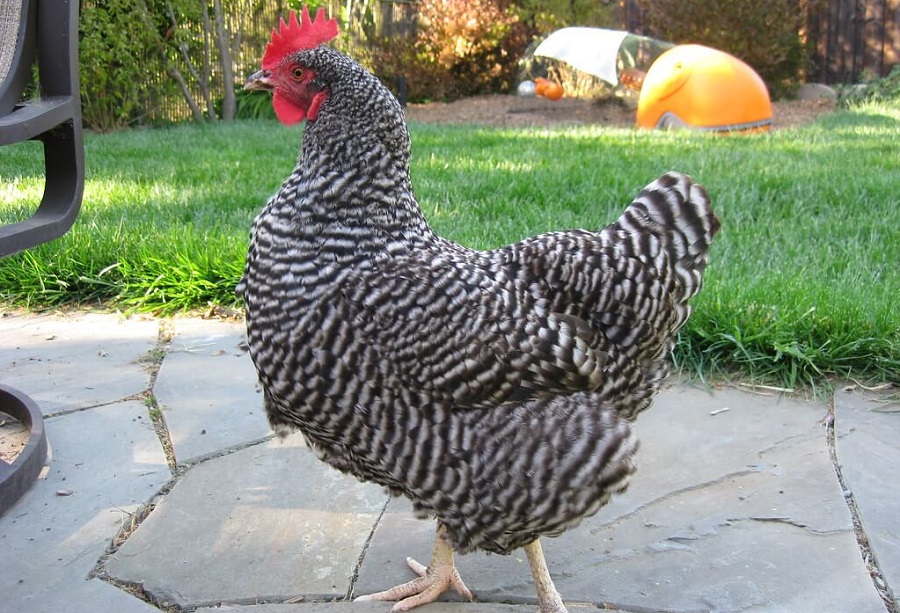Welcome to Part 2 of the best dual-purpose chicken breeds. Click here for Part 1 to check out the first 7 chicken breeds that are great for meat and eggs. These breeds grow to a large size and lay high numbers of eggs. Some even lay in the extremely cold winters of Canada!
8. Plymouth Rock Chicken: Pilgrim Stock
The Plymouth Rock is one of America’s oldest chicken breeds. It comes from the Dominique breed. The New York Poultry Society wanted to make the standard for the Dominique a rose comb as many Dominiques also had a single comb.
As a result, the Plymouth Rock became any “Dominique” chicken that didn’t have a rose comb. Today, the Dominique has more of a grey appearance while the Barred Plymouth Rock has more clear black and white bars in the coloring.
Barred Plymouth Rocks are also often called Barred Rocks. They disappeared for two decades in the 1800s.
Plymouth Rocks were the main source of chicken for the United States during World War II. At that point, they were the most popular breed in the United States. Families were encouraged to raise them during the war. But, after the war ended, they were replaced by commercial breeds.
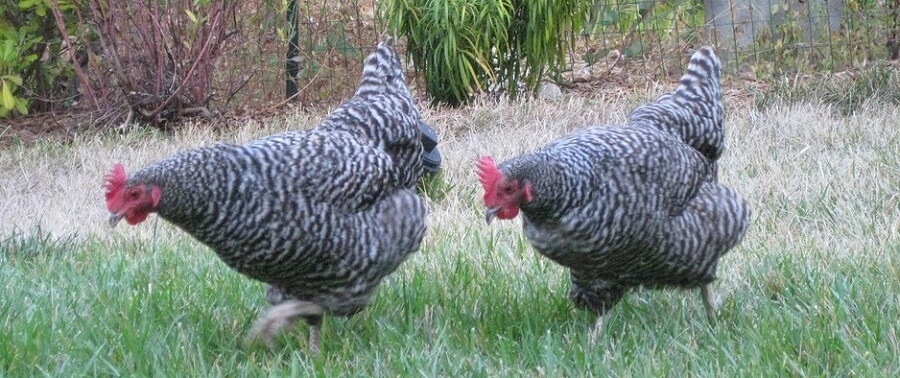
Photo Credit: Thomas Kriese Flickr
Reasons To Own Plymouth Rock Chickens
Plymouth Rocks are super useful chickens. They were bred for both meat and eggs. But, they are also friendly and easy to care for as well!
They lay 200-220 large, brown eggs a year. That equates to about 4 eggs a week. At the age of 3, the egg production drops.
Plymouths don’t go broody often but can be good setters and good mothers.
They are a larger bird. The roosters will grow to about 9.5 lbs (4.3 kgs), while the hens will reach 7.5 lbs (3.4 kgs). They are loved as meat chickens for their tender, tasty meat.
Physical Traits of Plymouth Rock Chickens
Plymouth Rock chickens come in several color varieties including barred, blue, buff, Colombian, partridge, silver, penciled, and white. Blue Plymouth Rocks are also called Sapphire Gems. White Plymouth chickens are called White Rocks. They are pure white in color.
Barred Rock Chickens are actually a Plymouth Rock breed. The “barred” part of the breed is a coloring identifier. Check out the Plymouth Rock chickens for a full history and information on Barred Rock
Their feathers should have barring of contrasting colors. The barring is light bars on dark feathers and is parallel.
They have a wide triangular body with a full breast and long back. They have yellow legs and a red comb and wattles. The comb is a single 5 point comb. The front and back points are shorter than the middle points.
Plymouth Rocks were admitted into the American Poultry Association in 1874. There are seven accepted varieties including barred, blue, white, buff, Colombian, partridge, silver penciled, and white.
The Poultry Club of Great Britain recognizes barred, black, buff, Colombian and white, but the European Association of Poultry accepts 10 variations.
Plymouth Rock chickens are considered a heritage chicken breed. They live a long and healthy life. Nearly all Plymouth Rocks chickens live at least 6-8 years. Some will even live longer than 10-12 years, but that is rarer.
Sapphire Gem Chickens
Sapphire Gems are also called Blue Plymouth Rocks. Sapphires are a sex-linked hybrid created in the Czech Republic. Sex-linked means that the chicks can be sexed by color.
Males are blue with a white dot on their head and females are blue with no dot.
The hens will lay about 290+ large to extra large brown eggs a year. That’s about 4-5 eggs a week! They will start laying at about 18-24 weeks old.
They are great foragers. They thrive in both hot and cold climates.
Caring For Your Plymouth Rock Chicken
Plymouth Rocks are mellow, docile and calm. They do ok with confinement if they have enough space to not get bored.
They are friendly toward chickens and children. They can become lap chickens. My daughter’s Sapphire Gem is happy ride around on the handlebars of her bike and started doing that at only about 6 weeks old.
They fly poorly. They are good for backyard chickens because even though they talk a lot, their talk is more like whispering than yelling.
They are very hardy in the cold and tolerant of the heat. They forage well. In the early pilgrim days, Plymouth Rocks were not fed, but were left to forage for their own food.
Plymouth Rocks are great for first-time chicken owners and a great addition to a flock. They are very self-sufficient and will forage very well. They have been foraging for all of their food needs for hundreds of years.
They are very weather tolerant. They do well in both hot and cold climates, as well as wet and damp climates.
They are listed as recovering by the American Livestock Breed Conservatory.
| Climate | Personality | Use | Size | Eggs/ Yr | Brooder | Forages |
| Hot & Cold | Gentle, Calm | Eggs & Meat | M: 9.5 lbs
F: 7.5 lbs |
220-290 | No | Yes |
- Hardy, self-sufficient chickens
- High egg production and loved as a meat bird
- Family-friendly
9. Langshan: An Ancient Asian Dual Purpose Chicken
The Lanshan was bred in China for many centuries. It is named for the area it comes from near the Yangtze Kiang River. To English speakers, Lanshan sounded similar to the Chinese pronunciation of the river.
Langshan chickens are a rare breed.

Photo Credit thelangshanclub.wildapricot.org
Primary Purpose of Langshan Chickens
It is a dual-purpose breed that does well with both white meat production and egg-laying. Roosters reach 9.5 lbs (4.3 Kgs) and hens grow to 7.5 lbs (3.4 kgs). The birds have a deep breast, which means a lot of white meat.
Langshan meat is whiter than much other white meat from chickens.
They are decent layers and lay about 3 eggs a week, which equates to about 200-220 eggs a year. The eggs are a medium brown. Langshans used to lay a very dark brown, almost purplish egg. But, in recent years, the coloring has lightened.
Langshans are faithful mothers and only go broody in April/May. They are not great setters though.
Langshan Chicken Features
They are tall birds with a depth of body. They have a U shaped back and are often described as having a wine glass shape.
After Langshans were imported to England, four varieties were bred. A shorter-legged version was bred and used to create the Orpington.
A long legs version free of leg feathering was bred and is called the “German Langshan.” The “Modern Langshan” was bred in England with long legs and less breast meat.
The original Langshan is now called the Croad Langshan, after the man who strove to preserve the original breed and to make it popular. It is also referred to as the Black Langshan.
It is the breed most commonly found in the United States. They were accepted into the American Poultry Association in 1883. Three colors are accepted by the APA: black, white, and blue. Langshan chickens live for more than 10 years, usually 10-15 years. They are considered a heritage breed of chicken in the U.S.
Caring For Your Langshan Chicken
Langhans are good foragers and hardy birds. They can fly over high fences.
They have light bones and tight feathering.
Langshan chickens can get hurt if their perches are too high. Make sure that you have lower perches to help keep them from breaking a leg when they jump off.
They are also hardy. They are well suited to southern climates and to colder climates. They do well on any soil type. If you have cold or wet winters, pay attention to their feathered feet, which can get cold easily.
They do very well in a free-range environment but also do well in confinement.
They are gentle birds and are easily tames. They make a good backyard, family chicken. They are listed in a watch status by the Livestock Conservancy.
| Climate | Personality | Use | Size | Eggs/ Yr | Brooder | Forages |
| Hot & Cold | Gentle | Meat & Eggs | M: 9.5 lbs
F: 7.5 lbs |
200 | Yes | Excellent |
- Very heat hardy
- Dual Purpose birds
- Rare, Long-living chicken
10. New Hampshire Chicken: Beautiful Red Dual Purpose Chickens
The New Hampshire Chicken doesn’t have the popularity they deserve! Although they were created within a few years of the Rhode Island Red, they never got as popular.
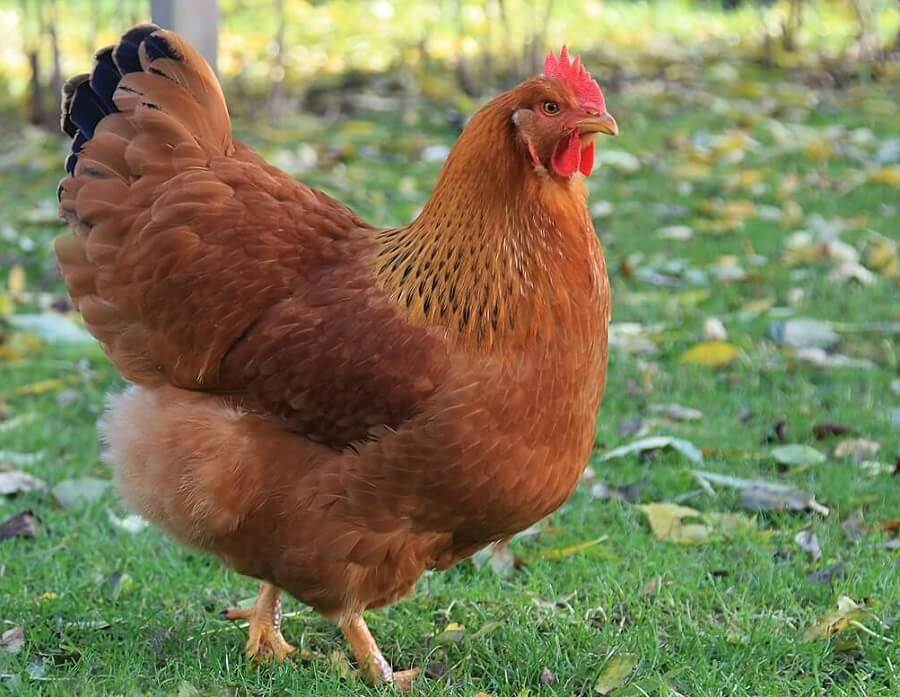
Photo Credit Domenwolf Flickr
Identifying A New Hampshire Chicken
The New Hampshire might be mistaken for a RI Red, but there are several differences. Their bodies are more triangular in shape with a broad body. They are about the same size, but the feathers are more chestnut, while RI Reds are more mahogany.
They have a single comb. They come in Red, white and blue-tailed. NH White and NH blue-tailed are very rare.
They were recognized by the American Poultry Association in 1935 in a red chestnut chest with black tail feathers. They will live for 6-8 years. Some New Hampshire Reds have lived as long as 12 years. They are considered a heritage breed of chicken.
Reasons To Raise New Hampshire Chickens
New Hampshire’s were bred by Professor “Red’ Richardson for meat and egg production. They are a dual-purpose bird.
The rooster grow to 8 lbs (3.6 Kgs) and the hens grow to 6.5 kgs (2.94 kgs). They make a good egg bird as well.
New Hampshire’s hens will lay about 200 large, tan eggs a year. That’s 3-4 eggs a week. The hens make excellent moms.
They get broody and are great setters so you won’t need an incubator to raise chicks.
New Hampshire’s are used in hybrids a lot and used for sexed chicks.
Caring For Your New Hampshire Chickens
They are gentle, friendly and aren’t ruffled much. That means they handle kids and pets well. They make a great backyard chicken and a pet chicken. They aren’t very noisy.
New Hampshires will be happy in little and large flocks. They can sometimes be aggressive to milder breeds. They also do great in confinement and free-ranging.
They are very cold-hardy and will free-range when other varieties stay inside the coop during cold months. They are less heat-hardy and will need shade during hot months.
They are listed in a watch status by the Livestock Conservancy.
| Climate | Personality | Use | Size | Eggs/ Yr | Brooder | Forages |
| Cold | Gentle | Eggs & Meat | M: 8 lbs
F: 6.5 lbs |
200 | Yes | Excellent |
- Great Dual Purpose Chickens
- Beautiful Red Plumage
- Cold Hardy
11. Jersey Giant: Largest Dual Purpose Chicken
Jersey Giants were originally called Black Giants. They were named after their creators, the Black Brothers.
In the last 1800s, John and Tomas Black wanted to breed a bird that could replace the turkey as a dinner bird. They succeeded in breeding the largest dual purpose bird.
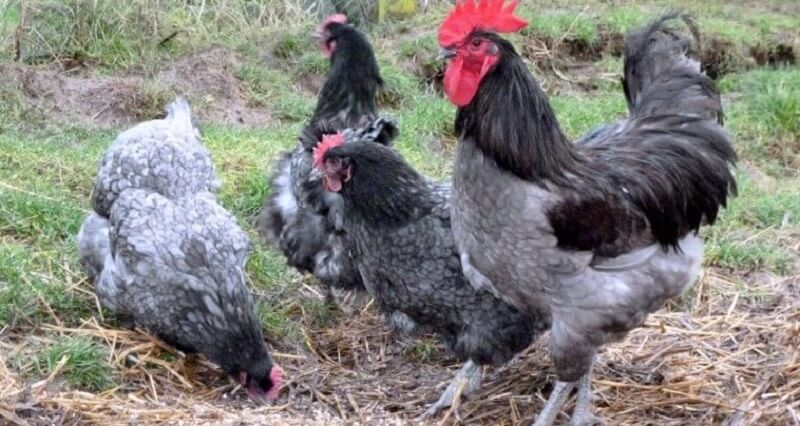
Primary Uses Of Jersey Giant Chickens
Roosters get 13-15 lbs (6 kgs) and hens get 10-11 lbs (4.6 kgs). Males can grow up to 26 inches tall while hens will grow up to 20 inches tall.
The Jersey Giant is a slow-growing bird. It takes up to 2 years to really flesh out. That means they will eat a lot more food than modern breeds for the amount of food they produce.
Jersey Giants are a heritage breed that lays about 4 eggs a week all year long. They lat 180-200 extra-large eggs a year.
Eggs range from a cream color to a dark brown. Hens are not broody.
Jersey Giant Chicken Features
They come in black, white, or blue feathering. Their feathers will have a beetle-green sheen on them in the light. They have a single, red comb, red earlobes, and four toes.
The body is deep and wide. The tail is relatively short for a bird of its size.
The Black coloring was recognized by the American Poultry Association in 1922. White Jersey Giants were recognized in 1947.
Jersey Giants live an average of 8-12 years. Jersey Giants are considered a heritage breed of chicken in the U.S.
Caring For Your Jersey Giant Chickens
Jersey Giants are calm and docile.
They have recently moved from critically endangered to the watch list. They are still rare in the United States.
Jersey Giants are gentle and mellow, but they aren’t great for city life because of their larger size. They enjoy foraging but do well in confinement.
They are also better adapted to cold than to heat. Their large bodies help them to stay warmer, but their combs are subject to frostbite.
They are listed in a watch status by the Livestock Conservancy, but only a few years ago, they were critically endangered.
| Climate | Personality | Use | Size | Eggs/ Yr | Brooder | Forages |
| Hot | Docile | Eggs & Meat | M: 13 lbs
F: 11 lbs |
200 | No | Yes |
- Largest Dual Purpose bird
- Slow growing
- Mellow Large & Friendly
12. Chantecler Chicken: The Best Cold Chicken Breed
Chantecler chickens are the only breed to be developed in Canada. A Trappist monk, Brother Wilfred Chatelain realized that none of the chicken breeds came from Canada. He set about developing a breed that would do very well in the sub-freezing winters of Quebec.
The Chantecler was introduced in 1918. It is a mix of four breeds, the Partridge Wyandotte, Partridge Cochin, Dark Cornish, and Rose Comb Brown Leghorn.
Even though the Chantecler is one of the best birds for frigid temperatures, it has never caught on in popularity like other breeds have. As a result, it usually has to be ordered through specific hatcheries that carry the breed.
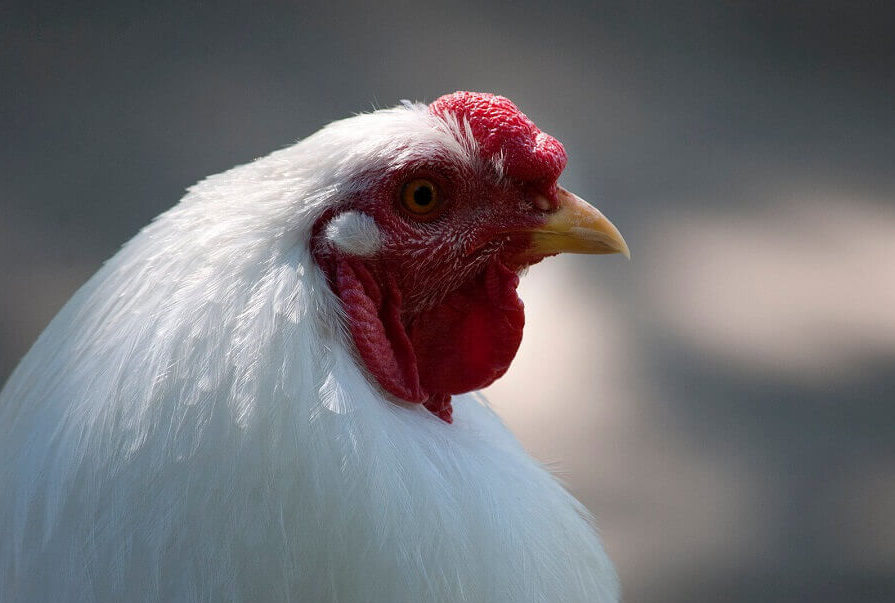
The Many Uses Of Chantecler Chickens
Chanteclers are good dual-purpose birds. They lay well in cold weather and will average 4 large brown eggs a week. That equates to about 150-200 eggs a year.
But, they are a slow starter and will take between 6-8 months to start laying.
The hens are broody and good mothers.
They get to a decently good size. Rooster will grow to almost 8 lbs in 20 weeks and will average out at 8.5 lbs (3.8 kgs). Hens will grow to 6.5 lbs (3 kgs).
Chanteclers have a well-fleshed out breast.
Chantecler Chicken Physical Traits
Chanteclers are white or partridge with yellow legs. They are a very no-frills chicken. They don’t have feathered feet or fluffy bottoms.
The Chantecler has almost no wattle and a very small comb. The beak is broad. It is a planer looking chicken.
It has very tight feathering, which keeps in the warmth. There are two accepted colors, white and partridge.
The Chantecler was first admitted to the American Poultry Association in 1921. The partridge color of Chantecler was admitted in 1935. It is a heritage breed of chicken. Chanteclers live for seven or more years.
Caring For Your Chantecler Chicken
Chantecler chickens are super cold hardy. They can withstand subarctic long winters.
They are not very heat hardy.
It can withstand frostbite because of the small wattles and comb. Their body is also a good shape that keeps the chickens warm.
Even though they are larger, they still lay eggs well in confinement. But, they will be more high-strung if confined to small spaces so you won’t want a large flock in a condo backyard.
They are gentle, calm and friendly. They can make a great family flock. If you live in a cold climate, they also make a great beginner chicken since they won’t need extra attention in the winter.
Chanteclers are also rare, even in Canada. The Livestock Conservancy lists them in a watch status. Other organizations list them as critically endangered. They can often only be purchased in small numbers. There are fewer than 2,000 Chanteclers worldwide.
| Climate | Personality | Use | Size | Eggs/ Yr | Brooder | Forages |
| Cold | Gentle, Friendly | Eggs & Meat | M: 8.5 lbs
F: 6. lbs |
150-200 | Good | Yes |
- Very Cold Hardy
- Dual Purpose bird that is slower laying
- Calm & Friendly
13. Faverolle Chickens: The Best French Breed
Faverolles originated in French and are named for the French origins. They come from an area north of Paris.
Faverolles are a mix of Houdan, Brahma, French Rennes, Flemish Cuckoo, Malines and Dorking.
They were introduced into England in 1894. They were imported to the United States in 1901.
They were bred as a dual purpose bird and were bred to tolerate confinement better than the then-popular Houdan birds.
In the 1900s, Faverolles were considered the best French breed produced to that point.
There was a lot of variety in the breed until the late 1800s when uniformity emerged.
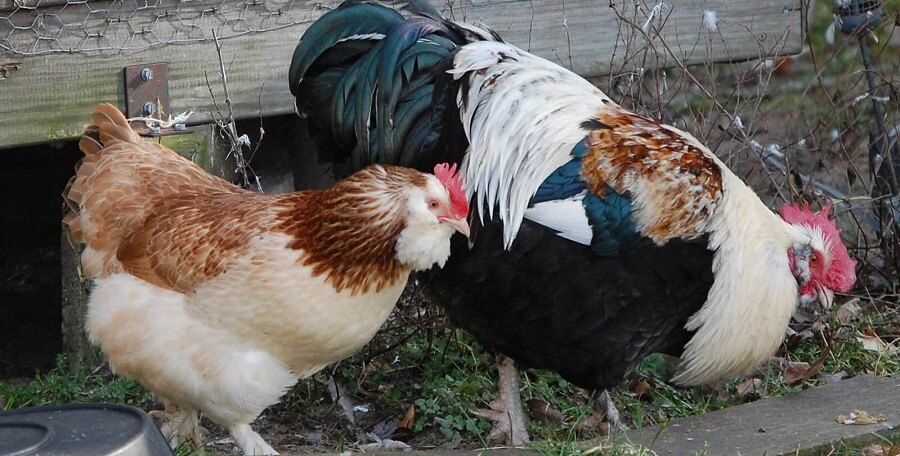
Photo Credit Nickon_nanny Flickr
Identifying Faverolle Chickens
Faverolles are odd-looking birds. They have muffs, fluffy faces, feathered feed, and 5 toes. The roosters are generally calm and the hens are sweet-natured.
They have almost no wattle and a red comb with 5 points.
Their coloring is salmon on the back, head, and wings. They have a white-colored breast. Faverolle roosters can be iridescent black. But, only white and salmon-colored are accepted by the APA. Salmon was first accepted in 1915.
Faverolle chickens will live for 5-7 years. They are considered a heritage chicken breed.
Reasons To Raise Faverolle Chicken
They are a dual-purpose bird that has mostly been used as an ornamental bird in recent years.
Even so, the French have a dish made entirely of Faverolle chicken.
The roosters are about 8 lbs (3.6 kgs) and the hens weigh about 6.5-7 lbs (3 kgs).
Faverolle hens lay between 150-180 medium, light brown eggs a year. That’s about 4 eggs a week, including winter. Some Faverolles will go broody, while some hens never become broody. That may differ based on specific parentage.
How To Care For Your Faverolle Chicken
Faverolles are very hardy in the winter but do less well in hot climates. They can be susceptible to leg mites. Additionally, their beards and feathered legs can get lice in them. Use Diatomaceous Earth to treat the lice.
They are very excited about living. They are generally happy and content.
They are usually submissive to other bird varieties and can be a loner in a flock.
But, they are friendly to people and cuddle. They are gentle with children and often make great pets.
Faverolles are talkative, docile. They have unique personalities and seem to be happy birds. They take confinement well but do like to have a quiet corner they can retreat to if things get a little too bustling in the coop.
They are listed as threatened by the Livestock Conservancy.
| Climate | Personality | Use | Size | Eggs/ Yr | Brooder | Forages |
| Cold | Gentle | Eggs, Meat & Decoration | M: 8 lbs
F: 6.5 lbs |
180 | Average | Yes |
- Dual Purpose Bird
- Docile, Happy & Friendly chickens
- Great for backyards.
14. Brahma Chickens: The King Of All Chickens
The Brahma used to be called The King of all the chickens. That’s because it has a very large size that has only recently been surpassed by the Jersey Giant.
There is a lot of controversy around the origin of the Brahmas since record keeping wasn’t great when they were first bred. It is believed that they came from a crossbreed involving the Shanghai breed, a large bird from China.
The Brahma and Cochin share the same ancestry and both claim to have originated as Shanghai chickens, but today, there are some specific differences in the breeds.
Brahmas became popular in 1852 when George Burnham, a breeder, sent 9 birds to Queen Victoria. She loved the gift, which was highly publicized. After that, a pair of Brahmas rose in price from about $12 a pair to over $100 a pair.
Dark Brahmas average 1 lb lighter than light Brahmas.
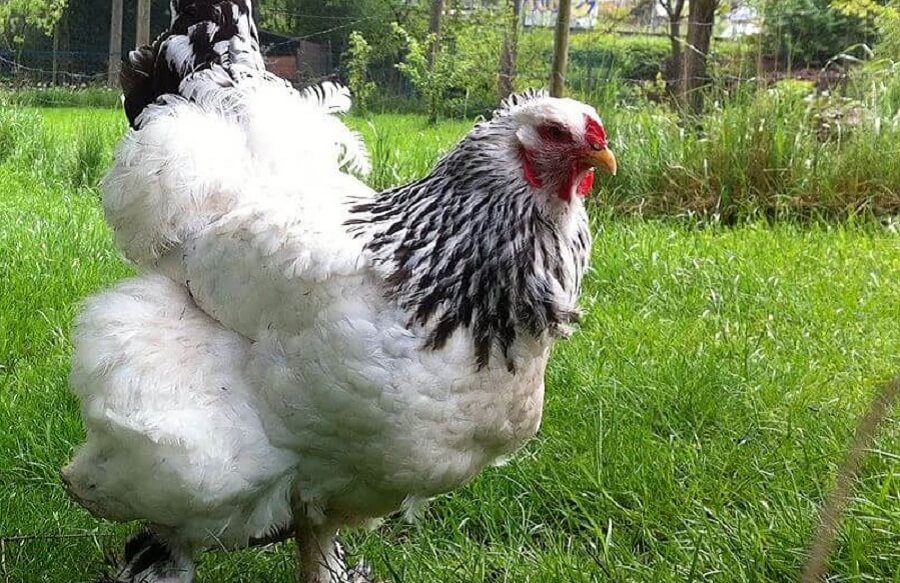
Brahma Chicken Uses
They were the leading meat chicken until the 1930s when Jersey Giants and other newer breeder were bred for faster and larger meat production.
They take about 8 months to mature. The virgin cocks are still tender at 12-13 lbs.
Brahmas were raised for meat production, but as newer breeds started growing faster, they went out of vast popularity.
The Brahma roosters can get as large as 18 lbs (8.15 kgs), but average about 12 lbs (5.5 kgs). Hens have weighed in at 14 lbs (6.35 kgs) and average about 10 lbs (4.5 kgs).
Although Brahmas aren’t used as much today for meat production, they do lay 3-4 eggs a week. That means about 120-150 eggs a year. They prefer to lay eggs October through May. That means that they can be a great supplement to regular hens who molt and take winter months off.
Brahmas will lay medium-large brown eggs. Hens take 6-7 months to start laying. They usually go broody in the early summer.
Physical Traits of Brahma Chickens
Brahmas come in three colors: light, dark, and buff. They stand 30 inches tall and are one of the largest chickens.
The dark Brahma have silver hackles. The light has a grey undertone. Buff contrasts black and buff coloring in a distinct pattern.
Brahmas have a short beak, small wattles, and a pea comb. They have a beetle brow. They also have feathered feet.
Their bodies are deep with a full breast. Their heads are smaller for their body size than other chickens.
Light and dark Brahmas were admitted into the American Poultry Association in the very first printing in 1874. Buff was admitted in 1924. They are considered a heritage breed.
Brahmas live for 5-7 years naturally.
Caring For Your Brahma
They like dry, drained soil. They also do well in moist cool climates. But, they are subject to frostbitten toes because their feathered feet collect mud and water. Their feathered toes and shanks have a tendency to collect water and mud.
As a result, special attention is needed if they are being raised in cold and wet conditions. But their pea comb and tight feathering help to protect them from cold weather.
They do best on cool, dry soil.
Brahmas don’t do as well in southern hot climates.
If Brahmas are raised in cold climates, then their feet should be watched for snow and mud clods, which will cause frostbite. They should also be watched for lice and fleas since they have tight feathering.
Otherwise, they are very hardy. They are robust and mild-mannered. They do well in confinement and can’t fly over fences very well. They will stay behind even a 2-3 foot fence.
They are also a good family pet, although they do require more monitoring in wet conditions than most beginners are aware of. They don’t fly well and are calm and docile.
Until recently the breed was considered rare. It is now listed as a recovering breed by the Livestock Conservancy.
| Climate | Personality | Use | Size | Eggs/ Yr | Brooder | Forages |
| Cool, moist | Calm | Meat | M: 12 lbs
F: 10 lbs |
120-150 | Yes | Yes |
- 2nd Largest Chicken. Still tender at 13 lbs
- Cool, wet climate tolerant
- Decent egg-laying
15. Lincolnshire Buff Chickens: Brought Back From Extinction, Literally
The Lincolnshire Buff hails from Lincolnshire, England. It was a very popular breed from about the 1850s to the 1900s for its rapid growth and table qualities.
At that time, buff birds were popular because the light feathers didn’t leave dark feather stubs in the skin and it looked better served on the table.
But, in 1895, William Cook, who was already a very popular poultry provider, introduced the Buff Orpington. Orpington chickens could sell for a lot more than any other brand of chicken.
Orpington chickens looked a lot like Lincolnshire’s, but Cook denied any similarity. By 1920, Lincolnshire chickens were extinct.
But, in 1986 a project to recreate the Lincolnshire commenced. Brian Sands continued the project, even after funding disappeared and was able to introduce a standardized Lincolnshire to the English.
Lincoln Buff is very rare, even in England.
It is derived from Red Dorking, Old English Game Bird, and Buff Cochin. Roosters are chestnut or copper-colored while hens are usually rich ginger.
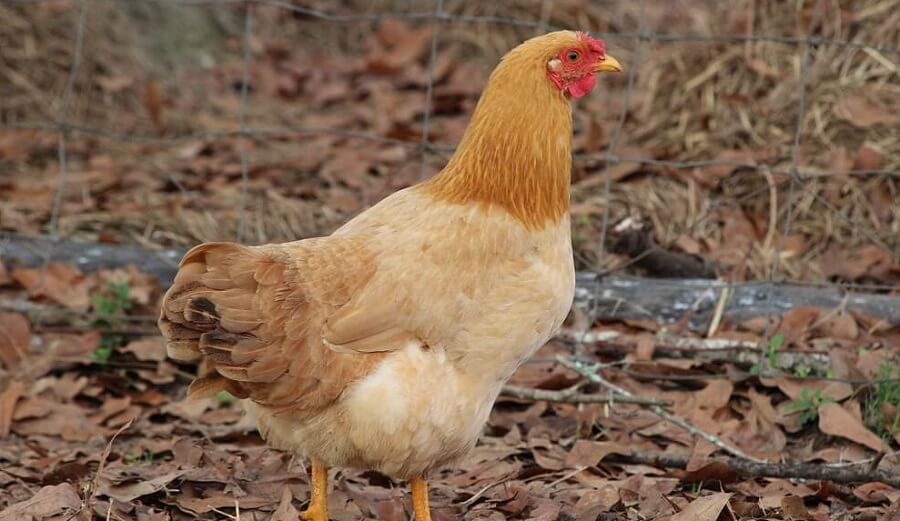
Photo Credit Alan Reeves Flickr
Identifying a Lincolnshire Buff Chicken
Today there are more differences between the Buff Orpington and the Lincolnshire than there were originally. The Lincolnshire has a longer back and closer feathering. The tail is lower. It also has a buff beak, white legs, and 5 toes
Lincolnshire Buffs are a buff color. They have a red comb and wattles. They have pale pink legs and feet.
They were recognized by the British Poultry Society in 1997.
Lincolnshire Buff Practical Uses.
Lincolnshire Buffs lays 120-150 tinted eggs a year. They are primarily raised for both eggs and conservation. The breed has very few flocks left.
Roosters are 9-11 lbs (4-5 kgs) and hens grow to 7-9 lbs (3.1-4 kgs).
Caring For Your Lincolnshire Buff
There are possible only a dozen or so Lincolnshire chickens are very practical. They are well-suited for foraging. They have a mellow temperament and are friendly chickens.
They are exceedingly rare. It will take some due diligence to find a true Lincolnshire Buff to raise.
For more information, check out https://lincolnshirebuff.co.uk/lincolnshire-buff-standard/
| Climate | Personality | Use | Size | Eggs/ Yr | Brooder | Forages |
| Cold & Wet | Unknown | Meat & Eggs | M: 10 lbs
F: 8 lbs |
130 | Yes | Yes |
- Very rare, rebred from extinction
- Dual purpose birds
- Mellow, friendly chickens
Conclusion
It can be overwhelming to decide which type of chicken to raise. All of these breeds are great chickens that are friendly and will be mellow if raised from a chick.
Most chicken breeds can do well free-ranging, but those that are better suited for backyards will often eat more feed than chickens that do well free-ranging.
In addition, most chickens can do well in the hot or cold weather, but if they are less suited to those climates, they will need additional care to stay healthy.
Don’t forget to check out the next article in our series on the Best Meat Chicken Breeds for Growth & Taste.
| Chicken Breed | Eggs / Year | Rooster Weight | Backyard or Free Range? | Cold, Hot, Or Wet Climate Hardy | Family Pet? |
| Austra White | 240+ | 7 lbs | Backyard & Free Range | Cold & Heat | Yes |
| Australorp | 300+ | 10 lbs | Free Range | Cold & Heat | Yes |
| Black Star | 250-300 | 8 lbs | Backyard – quieter | Cold & Heat | Yes – lap chicken |
| Brahma | 120-150 | 18 lbs | Need Room | Cold Hardy Not Wet | Yes |
| Chantecler | 150-200 | 8.5 lbs | Free Range | Very Cold Hardy | Yes Calm |
| Dominique | 230-270 | 7 lbs | Backyard & Free Range | Cold & Heat | Yes Kid Friendly |
| Faverolle | 150-180 | 8.5 lbs | Backyard & Free Range | Cold Hardy | Yes Cuddly |
| Jersey Giants | 180-200 | 13-15 lbs | Backyard & Free Range | Heat Hardy | Yes Friendly |
| Langshan | 200-220 | 9.5 lbs | Backyard & Free Range | Cold & Heat Hardy | Yes |
| Lincolnshire | 120-150 | 9-11 lbs | Free Range | Cold & Heat Hardy | Yes Mellow |
| New Hampshire Red | 200+ | 8 lbs | Backyard & Free Range | Cold Hardy | Yes great with pets |
| Orphington | 200-280 | 8.6 lbs | Backyard Lazy Foragers | Cold Hardy | Yes! |
| Plymouth Rock | 200-220 | 9.5 lbs | Excellent Foragers | Cold & Heat Hardy | Yes Family Friendly |
| Rhode Island Red | 200-300 | 8.5 lbs | Any Situation! | Very Hardy In any climate | Yes |
| Wyandotte | 260+ | 8.5 lbs | Free Range | Cold Hardy | Yes Calm |
Feature Photo Credit: Flickr Thomas Kriese
My Favorite Chicken and Duck Supplies
This list contains affiliate products. Affiliate products do not cost more but helps to support BestFarmAnimals and our goal to provide farm animal owners with accurate and helpful information.
Manna Pro Oyster Shell keeps eggs strong. Before I gave my chickens oyster shell, I had the oddest eggs, many with weak and irregular shells. Now, I don’t have an issue.
Layer Feed by Manna Pro. I like pellets rather than crumbles as my chickens eat them better and less gets wasted or scavenged by rodents. A good layer feed makes the difference in hens laying many more eggs.
My chickens love this mealworm treat, which gives added protein, something that’s great during molting and winter months.
There are many ways to feed and water your chickens. I like this food and water setup the best because it reduces waste, saves me time feeding and watering, and keeps the food fresh longer. Except, in the winter, I use a heated waterer. The only problem is the heated waterers need to be replaced every few years.
I love this chicken veggie hanger. It makes it easy to give your chickens produce from the garden and keep them occupied in the winter with a fresh head of lettuce.
These chicken toys are a hoot! They will help curb bullying and keep your chickens active, especially in the winter when hens tend to get more lethargic.

